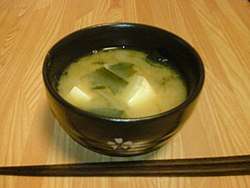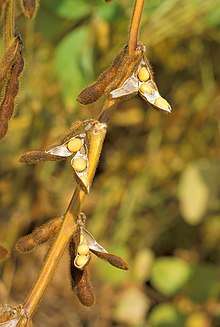Miso soup
Miso soup (味噌汁, misoshiru) is a traditional Japanese soup consisting of a dashi stock into which softened miso paste is mixed. In addition, there are many optional ingredients that may be added depending on regional and seasonal recipes, and personal preference.
 | |
| Type | Soup |
|---|---|
| Place of origin | Japan |
| Serving temperature | Hot |
| Main ingredients | dashi stock, miso paste |
| Similar dishes | Doenjang-guk, doenjang-jjigae |
Along with suimono (clear soup), Miso soup is considered to be one of the two basic soup types of Japanese cuisine.[1]
Miso paste
The type of miso paste chosen for the soup defines a great deal of its character and flavor. Miso pastes (a traditional Japanese seasoning produced by fermenting soybeans with salt and the fungus Aspergillus oryzae, known in Japanese as kōjikin (麹菌), and sometimes rice, barley, or other ingredients) can be categorized into red (akamiso), white (shiromiso), or mixed (awase).[2] There are many variations within these themes, including regional variations, such as Shinshū miso or Sendai miso.
A miso paste that has been fermented for a longer period of time, such as a red miso, gives the miso soup a stronger, deeper flavor. A miso paste that has been fermented for a shorter period of time, such as a white miso, provides a lighter, sweeter flavor.[3]
More than 80% of Japan's annual production of miso is used in miso soup, and 75% of all Japanese people consume miso soup at least once a day.[4]
Stock
The most common dashi soup stocks for miso soup are made of niboshi (dried baby sardines), kombu (dried kelp), katsuobushi (thin shavings of dried and smoked bonito (similar to skipjack tuna)), or hoshi-shiitake (dried shiitake). The kombu can also be used in combination with katsuobushi or hoshi-shiitake. The kelp and/or shiitake dashi serve as a vegetarian soup stock.[5]
Outside Japan, American or European style miso soup is sometimes made by dissolving miso in a Western vegetable stock. The stock might include ingredients such as negi, carrot, potato and daikon radish. In some versions of the dish, chicken stock, Western-style fish stock, and other non-dashi bases can even be used, but there is some debate over whether or not miso soups made using these non-traditional bases count as true miso soup.
Other ingredients
According to Japanese custom, ingredients are chosen to reflect the seasons and to provide contrasts of color, texture, and flavor. Thus negi and tofu, a strongly flavored ingredient mixed with a mildly flavored ingredient, are often combined. Ingredients that float, such as wakame seaweed, and ingredients that sink, such as potatoes, are also combined. Ingredients may include mushrooms, potatoes, seaweed, onion, shrimp, fish, clams, and sliced daikon. Nearly any Japanese ingredient is added to some type of miso soup. However, typical miso soup recipes contain a small number of additional ingredients beyond dashi stock and miso.
If pork is added to miso soup, it is called tonjiru, meaning "pork soup".
Hearty and robust cold weather variations may include daikon, deep-fried tofu called abura-age, potatoes, onions and dark miso varieties. Lighter variations are better suited for spring or summer months and made with ingredients like bok choy, kale, and chard.[6]
Preparation and serving
Miso soup can be prepared in several ways, depending on the chef and the style of soup. Japanese recipes usually call for most vegetables and meats to be cooked in the simmering dashi, particularly mushrooms, daikon, carrots, potatoes, tofu, and fish. The miso is suspended separately in some dashi stock removed from the simmering mix, to keep the miso paste from cooking, which alters the flavour, kills beneficial bacteria, and reduces the health benefits of biologically active miso paste. When the vegetables are cooked, the stock is removed from heat, the miso suspension is added and mixed into the soup, any uncooked ingredients are added, and the dish is served.
In Japan, miso soup and white rice make up the central dishes of the traditional Japanese breakfast. The soup has been a favorite of commoners and royalty alike for many centuries, but there are also many other dishes involving breakfast. They are all quite small, some include egg, fish, and nattō which is a fermented soy bean. The soup is usually served in lacquer bowls with lids and drunk directly from the bowl, though the solid ingredients are eaten with chopsticks. The bowl sometimes has a lid to keep heat and aroma in as well as to improve the presentation.[7]
Instant miso soup
Instant miso soup is available in single-serving packets. It is usually sold in dehydrated powder and paste forms, though it sometimes also sold freeze dried. It generally contains dried toppings such as wakame and tofu with soy beans that reconstitute rapidly on the addition of hot water.[8] These are popular in the Japanese workplace, where miso soup can be made with lunch as easily as green tea and using the same water. Instant miso soup is available in many grocery stores outside Japan. It has a shelf life of 3 to 12 months.
Wappani
Wappani (wappani (わっぱ煮) is a miso-soup-based dish unique to Awashima island off the coast of Niigata, Japan. A cedar flask ("wappa") is filled with miso soup, fish and vegetables and it is heated by dropping in hot rocks, which quickly bring it to a simmer. Hot rocks retain their heat for hours after being taken from the fire, so a hot meal can be prepared without the use of fire.[9]
Health benefits
In 2003, researchers at Japan's National Cancer Centre suggested that "eating three or more bowls of the Japanese delicacy Miso soup every day could cut women's risk of developing breast cancer".[10] Miso soup also tends to be relatively low in calories, but is filling because of the high protein content.
References
- Sakai, Sonoko. Japanese Home Cooking: Simple Meals, Authentic Flavors. Roost Books. p. 118.
- "What Is Miso Paste, Anyway, And How Do I Use It? Help!". HuffPost. 2016-04-26. Retrieved 2018-12-14.
- Delany, Alex. "5 Ways to Use Miso That Don't Involve Soup". Bon Appetit. Retrieved 2018-12-14.
- Shurtleff, William; Aoyagi, Akiko (2001). The Book of Tofu & Miso. Ten Speed Press. ISBN 1-58008-358-7.
- "How To Make Miso Soup". Kitchn. Retrieved 2018-12-14.
- Schinner, Miyoko Nishimoto (1999). Japanese Cooking:Contemporary and Traditional.
- Matsune, Kaz (21 October 2016). "Why Is Miso Soup Sometimes Served With a Lid?". Slate. Retrieved 21 October 2016.
- MATCHA. "A Great Souvenir! Learn How To Make Instant Miso Soup". MATCHA - JAPAN TRAVEL WEB MAGAZINE. Retrieved 2018-12-14.
- "Wappani - 【郷土料理ものがたり】". kyoudo-ryouri.com. Retrieved 2018-12-14.
- "Miso soup 'cuts breast cancer risk'". 2003-06-18. Retrieved 2018-12-14.
Further reading
- The Miso Book: The Art of Cooking with Miso, by By John Belleme & Jan Belleme, Square One Publishers
